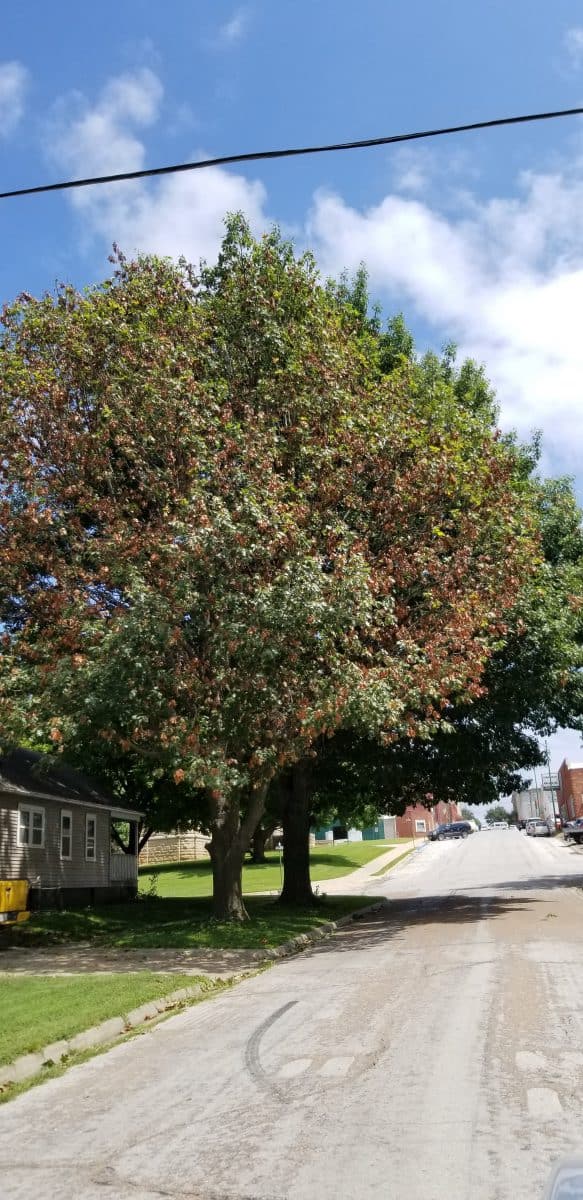All of us who have oaks really love the shade that these mighty trees give. But we also know that most are slow growing, and have a variety of pests and diseases that affect them each year. The damage from Kermes scale is very noticeable, making our lovely trees stand out in the crowd of maples, elms, and other trees.

What is Kermes Scale?
Kermes scale is a type of small, plant juice sucking insect that is found throughout the United States. In North America, there are around 32 species of scale referred to as Kermes scales. These tiny insects are between 1/16 and 1/4 inch long, shaped like a tiny marble when mature.

What trees are Kermes scale found on?
Here in Kansas, we have 3 types of Kermes scale scattered through our oak forests, landscapes, and cities. The most common species are the Red Oak and Pin Oak Kermes scale. The trees most affected include red, pin, black, Shumard, and sawtooth oaks.
Other trees affected include members of the white oak group, such as white, bur, swamp white, post, and chinkapin.
All of these oaks can be found scattered throughout Kansas, mostly in urban settings.
What is the damage caused by Kermes Scale?
Kermes scale cause damage to the new growth of trees by sucking plant juices by leaf buds and eventually girdling the new growth from the previous year’s growth. This causes flagging in the tree when summer gets hot or when the tree is stressed.
What is the life cycle of these pests?
Red and Pin oak Kermes scale have the same life cycle, while the bur oak scale is different. Once you know the life cycle, you can begin to get a handle on what needs done to protect your tree.
The pin oak Kermes scale starts feeding in the spring (usually April to May) as nymphs, or “teenagers”. These nymphs feed and develop hard outer coverings as they transform into adults. The female adult scale then lays eggs and dies in late summer. There can be thousands of eggs inside the body of the dead female.

The eggs hatch in September or October and overwinter on the tree as nymphs. They spread from tree to tree by wind, by crawling from branch to branch, or by unwitting birds or animals (squirrels, raccoons, etc.).

Are there natural enemies of Kermes scale?
There are natural enemies of all insects. It is important to know that even though you may treat a tree for one insect, you may be unknowingly killing something good.
The larvae and adults of lady beetles and lacewings feed on the crawlers (nymphs) of scale insects. They keep the population of such insects under control. Instead of having your whole tree covered with brown leaves on the tips, we mostly see a scattering or flagging of branches.
When you see a larger amount of the tree with brown flagging, you will likely find an area that has fogged for mosquitoes, or sprayed the yard with a systemic insecticide, killing both the good and the bad.
Another natural enemy of scale are parasitoid wasps. These minute wasps do not sting humans, but rather lay their eggs in the nymph or adult stage of other insects. Once hatched, their larvae feed from the inside, killing the pest.
Can I apply a chemical application on my tree for scale?
Reasons to consider a chemical application include:
- The tree has been suffering from drought, heat, or other weather stresses
- There has been an outbreak of Kermes scale within the area and natural predators cannot keep up
- You live in an area where natural predators are few (urban areas)
What chemical do I apply and when do I apply it?
The best time to kill scale is when it is in the crawler or nymph stage. At this time, the insects have not yet developed the waxy coating that resists chemicals.
There are 3 recommended treatments for killing Kermes Scale, 2 of which will harm few natural predators.
- Dormant Spraying – This application is done in late winter (February or March), when the temperatures are above freezing for several hours. Apply horticultural or dormant oil to the trees with a sprayer. The oil suffocates the insect, killing it. This is least likely to kill natural predators, as most overwinter in leaf litter or as eggs.
- Systemic Drench or Injection – This is done by applying a systemic insecticide containing imidacloprid to the tree with a soil drench or chemical injection. The chemical is taken up by the roots and then the phloem of the tree, transferring it to all leaf veins, where scale sucks plant juices. It protects the tree for 1 year after application. It is best applied in October in Kansas.
- Fall Chemical Spray – This is a chemical application of bifenthrin or lambda-cyhalothrin applied in September or October to kill newly hatched crawlers. However, this is most likely to kill beneficials and bees, and I do not support the use of this method.
Conclusion
Here at Grimm’s Gardens we recommend the use of a systemic soil drench to prevent and kill tree pests. Besides Kermes scale, pests controlled with this application include aphids, spider mites, mealybugs, and other types of scale insects.
If you would like to have a bid to have your tree treated for scale or looked at for other concerns, call 785-459-2586 today or send us a message!





Why do you recommend the Systemic drench and not either of th sprays?
The systemic drench is less harmful to other insects. I prefer not to spray trees, especially ones covered in all manner of wildlife, from birds, to bees, to beetles. Injections and drenches are far safer to other life forms and safer for the applicator too.